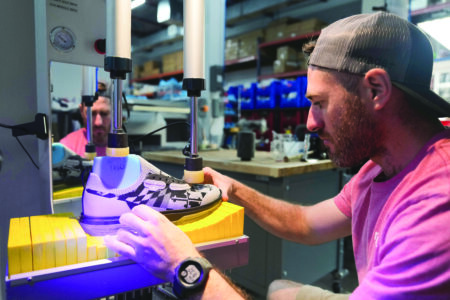Grandparents Teach, too
Discovering dinosaurs intrigues kids

Sabin, Davis, Hetrick, Anderegg, Macalady, Walker, Darling, and Katers
Children love dinosaurs so much they can be used to teach almost anything. You’ll need a package of small dinosaurs, small river or flat rocks, an up to date dinosaur book, paper and markers.
Take along along your dinosaur gear to the beach and start a conversation. Have your children seen the PBS series “Dinosaur Train”? Although it is a cartoon, the information is provided by paleontologists. You can visit the library for books about dinosaurs such as National Geographic’s “Little Kids First Big Book of Dinosaurs” by Catherine D. Hughes. How big or small were dinosaurs? Where did they live? What happened to them? Young children can often learn scientific dinosaur names and information with very little practice.
Building Dens
According to paleontologist Anthony Martin in “Science” small cold climate dinosaurs burrowed in rocks for the winter. These rock burrows are found in Montana and Southern Australia. The burrows kept small bird like dinosaurs and the plant-eaters or herbivores warm and safe from carnivores, the meat eaters, about 105 million years ago.
Begin by discussing dinosaur dens. Small bird like dinosaurs are usually not in dinosaur packages so you can use what is available. Also, if this were real and not a game, all the dinosaurs in the den would be the same kind.
Give your child a dinosaur, some rocks, and begin building the first den. The den must be just the right size for one dino to be very snug. How many rocks were used to build? Make a drawing of the den and record the number of dinosaurs next to it. Discuss the strategies and problems involved in constructing the walls and ceiling of the den. How did you know which rocks to use? How did dinosaurs build dens?
Then give your children a second smaller dinosaur. They can estimate how many more rocks will be needed to rebuild a second den and draw a plan. Construct a snug den for two dinosaurs. Count out the rocks together. Ask questions such as “Is this enough? Do we need more?” Remind them it is OK to come back for more rocks. The second time they might use fewer rocks because they have practiced. Keep the game going by adding more dinosaurs, estimating rocks, and rebuilding.
If you are on the beach, children can make a stream going by the den and add some twigs for trees.
Math Vocabulary
Building these dens develops mathematical and scientific vocabulary, plus dexterity. Young children learn how to visualize, plan, and build from a model.
Children can make permanent dens by gluing the rocks together on piece of cardboard when they get home. They make a nice addition to their sandbox fun. For more see grandparentsteachtoo.blogspot.com and wnmufm.org for live and podcast programs; Facebook and Pinterest.
Thanks!
EDITOR’S NOTE: Grandparents Teach, Too is a non-profit organization of elementary and preschool teachers from Marquette, Michigan. The writers include: Jan Sabin, Mary Davis, Jean Hetrick, Cheryl Anderegg, Esther Macalady, Colleen Walker, Fran Darling, and Iris Katers. Their mission since 2009 is to help parents, grandparents, and other caregivers of young children provide fun activities to help prepare young children for school and a life long love of learning. They are supported by Great Start, Parent Awareness of Michigan, the U.P. Association for the Education of Young Children, Northern Michigan School of Education, the Upper Peninsula Children’s Museum and the Northern Michigan University Center for Economic Education.





